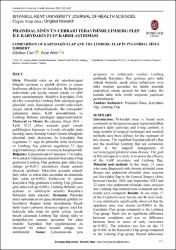Pilonidal sinüs’ün cerrahi tedavisinde Limberg flep ile Karydakis flep karşılaştırması
Künye
Can G, Aren A. Pilonidal sinüs’ ün cerrahi tedavisinde Limberg flep ile Karydakis flep karşılaştırması. IKUJHS. 2023;2(3):13-21.Özet
Giriş: Pilonidal sinüs en sık sakrokoksigeal bölgede rastlanan ve günlük aktivite ve yaşam konforunu etkileyen bir hastalıktır. Bu hastalığın tedavisinde çok sayıda cerrahi teknik ve tıbbi metot tanımlanmıştır. Modifiye Karydakis flebi ve modifiye Limberg flebi sakrokoksigeal pilonidal sinüs hastalığının cerrahi tedavisinde yaygın olarak kullanılmaktadır. Bu retrospektif çalışmanın amacı, KAR prosedürünün ve Limberg flebinin etkinliğini değerlendirmektir. Materyal ve Metot: Bu çalışma, Ekim 2011 – Eylül 2012 yılları arasında genel cerrahi polikliniğine başvuran ve kronik pilonidal sinüs hastalığı tanısı konulup Genel Cerrahi kliniğinde pilonidal sinüs eksizyonu ile Karydakis flep uygulanan 31 olgu ile pilonidal sinüs eksizyonu ve Limberg flep yöntemi uygulanan 32 olgu değerlendirmeye alındı ve sonuçlar karşılaştırıldı. Tartışma: Pilonidal sinüs toplumda en sık genç erkeklerde görülen bir hastalıktır. Bugüne kadar tanımlanmış birçok farklı tedavi yöntemi olmasına rağmen, total kür hakkında hala ortak bir görüş yoktur. Ancak birçok çalışmada Limberg flep tekniği nüks ve komplikasyon oranları açısından bir adım öndedir. Karydakis flep uygulamasının da alternatif bir tedavi metodu olduğu öne sürülmüştür. Sonuç: Çalışmamızda yara ayrışması ve enfeksiyon oranları Limberg grubunda Karydakis flep grubuna göre daha yüksek bulundu, ancak erken enfeksiyon veya nüks oranları açısından iki teknik arasında istatistiksel olarak anlamlı bir fark yoktu. Bu konuda daha fazla klinik araştırma yapılması gerekmektedir. Introduction: Pylonidal sinus is found most
commonly in the sacrococcygeal region and affect
patient’s daily activities and living comfort. A
large number of surgical techniques and medical
methods have been defined for the treatment of
this disease. The modified Karydakis(KAR) flap
and the modified Limberg flap are commonly
used in the surgical management of
sacrococcygeal pilonidal sinus disease. The goal
of this retrospective study is to assess the efficacy
of the KAR procedure and Limberg flap.
Material and method: In this study, 31 cases
who were diagnosed with chronic pilonidal sinus
disease and underwent pilonidal sinus excision
and Karydakis flap in the General Surgery clinic
between October 2011 and September 2012 and
32 cases who underwent pilonidal sinus excision
and Limberg flap method were evaluated and the
results were compared. Results :In our study, 17
of the 63 patients were female and 46 were male.
It was statistically significantly observed that the
operation time was shorter (p<0.001) in the
Karydakis Flap group compared to the Limberg
Flap group. There was no significant difference
between complaints and was no difference
between them in terms of early recurrence
(p=0.982). The infection was less on day 15
(p=0.006) in the Karydakis Flap group compared
to the Limberg Flap group. Wound dehiscence and infection rates were higher in Limberg flap
than in Karydakis flap. Discussion: Pylonidal
sinus is a common disease in society and refers to
the young males most commonly. Although there
had been many different treatment methods
defined until today, there is stil not a common
opinion about total cure. In many studies,
Limberg flap technique is one step ahead in means
of recurrence and complication rates The KAR
procedure has also been suggested to be an
alternative treatment method. Conclusion: In our
study rates of wound dehiscence and infection
were found to be higher in Limberg group
compared to the Karydakis Flap group but, there
was not a statistically significant difference
between the two techniques in means of early
infection or recurrence rates. There is need to be
make more clinical research about this subject.
Kaynak
Istanbul Kent University Journal of Health SciencesCilt
2Sayı
3Bağlantı
https://dergipark.org.tr/tr/pub/ikujhs/issue/81689/1351111https://hdl.handle.net/20.500.12780/816
Koleksiyonlar
- Makale Koleksiyonu [12]


















